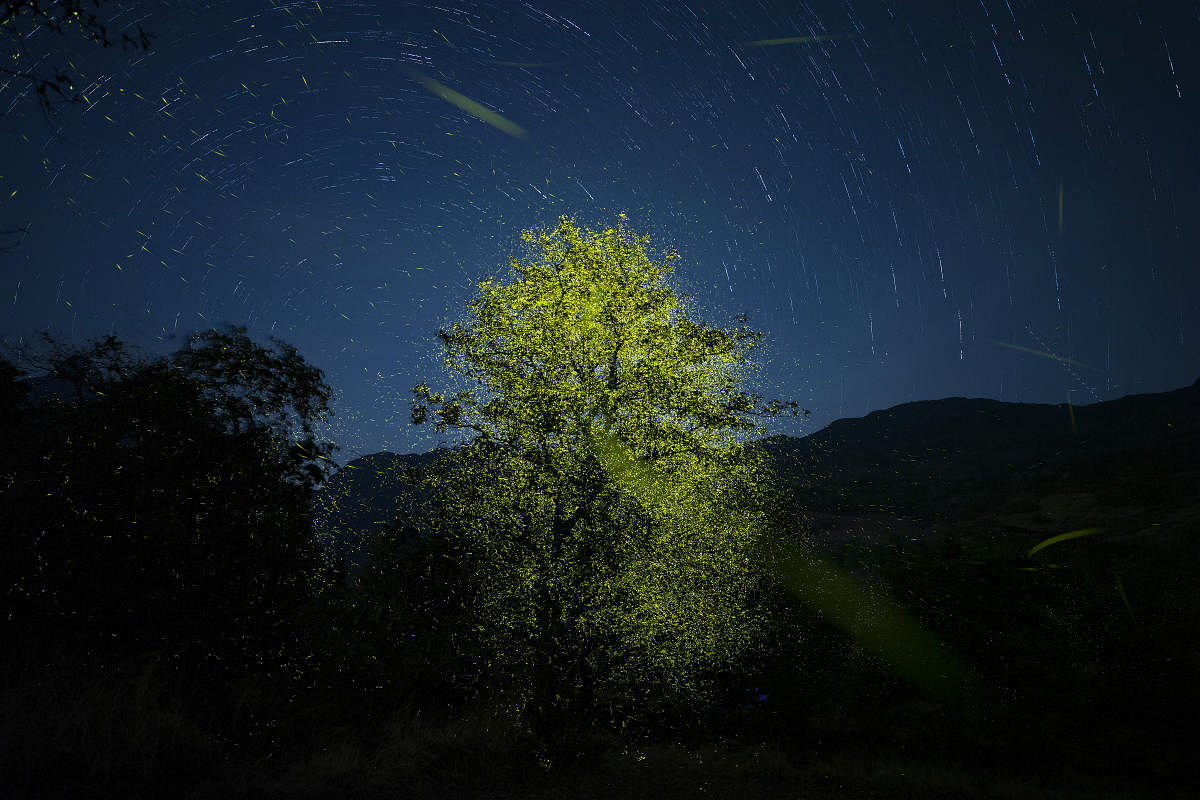
They have a universal attraction. In the darkness of the night when a couple of small yellowish-green fluorescent lights streak by, you aren’t only startled but are happily excited. And age doesn’t matter at all. The exhilaration of sighting fireflies (jugnu in Hindi, minchu hula in Kannada) is unanimous. So just imagine the surreal feeling when one spots a ‘glowing’ tree in the dark night in a forest with celestial stars becoming mute spectators to this natural beauty.
“The first sight was eerie, unbelievable, and made me forget that there may be predatory animals or reptiles lurking by in Bhandardara where sometimes leopards are sighted. The view of the lit-up wild fig tree was so beautiful that I almost forgot my main aim of reaching the place — to photograph the cluster of fireflies,’’ recalls a very happy 23-year-old Aishwarya Sridhar about her international award-winning photograph titled ‘Lights of passion’, under the Highly Commended category by the Natural History Museum, London. She is the youngest Indian woman to be awarded in this category. The award, in its 56th year, is recognised the world over as the best wildlife photography award.
Aishwarya was fascinated by the flying small lights in the night around her home in Panvel located about 50 km away from Mumbai. She is lucky as Panvel in Raigad district of Maharashtra, still retains open spaces, lot of green cover (though fast depleting) around it, to sight fireflies. The famous Karnala bird sanctuary is just about 13 km away from this city. A fleeting visit by these fireflies in the month of June, a couple of years ago, kindled the curiosity of this mass media graduate, wildlife photographer, documentary filmmaker, and a member of the State Wetland Identification Committee.
Early learner
Her tryst with wildlife photography began when her father, a member of Bombay Natural History Society presented her with a point and shoot camera for her 11th birthday and started taking her on his nature treks. A ‘Google’s child’, she learnt all her photography lessons from YouTube classes. Her first documentary film on Panje—the last wetland is the result of her observations from her childhood of the fast-depleting greenery around this wetland which is home to lakhs of migratory birds.
“I started observing that the wetland was slowly getting destroyed by the construction debris being dumped and a wall built to stop the seawater from entering the wetland which is the source of survival for the wildlife in this region,’’ recalls Aishwarya who was elated when her debut film was nominated in the best film in fusion category at the National Science Film Festival and was telecast on DD National. Her next film Queen of Taru was about a tigress named Maya in the forest of Tadoba Andhari Tiger Reserve in Chandrapur in Maharashtra. The film got her the Best Film Award in Amateur /Emerging category at the 9th Wildlife Conservation Film Festival, New York in 2019.
Picture perfect
Aishwarya admits that though photography is all about spontaneous shots, to make a statement and be heard, one needs to plan, study animal behaviour and picturise the area to be shot.
Like for her recent award-winning photograph of fireflies, she did extensive research. She found out that their mating season starts just before the monsoon when they become hyperactive and Bhandardhara is one of their frequented homes. The locals and some activist friends who along with her are fighting to save the wetlands of Panje, Uran, and other places, helped her plan her nocturnal trip to the area in the forest. So armed with her camera and a local man, she reached the place. “When I focused, I realised that the clear night sky with bright stars shining formed a lovely background. So I shot some 27 frames and stitched them to get a star trail background to the fireflies filling the wild fig tree,’’ explains Aishwarya. Her aim is to make more films and to make people aware of what they would lose if they don’t take care of their planet Earth.